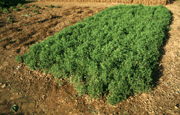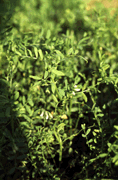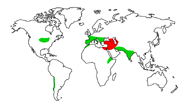Lentil (Lens culinaris)
Pea family
(Fabaceae)

| 
|
| Lentil crop in field. | Lentil plant with flowers
|
Source: Bock D., MPI Köln
Distribution, Yield, Use:
Production (1000t) Yield (dt/ha)
| Country | 1979-81 | 1992 | 1979-81 | 1992
|
| Turkey | 220 | 600 | 10.6 | 7.7
|
| India | 410 | 750 | 4.4 | 6.5
|
| Syria | 60 | 50 | 7.7 | 6.0
|
| Nepal | 50 | 75 | 5.0 | 6.3
|
| Canada | 32 | 350 | 8.2 | 13.0
|
| World | 1330 | 2400 | 6.0 | 7.6
|
- Distribution:
Predominantly grown in Turkey, India, Syria, Nepal,
Canada, Ethiopia and Spain.
Requires a warm, dry climate and well-drained soil.
- Use:
Foodstuff
- Seeds for soup, broth.
- Unripe capsules as vegetable.
- Animal feed (seed, green material)
25% protein, 60% carbohydrate
1% fat in ripe seeds.

Region of origin:  Region of cultivation:
Region of cultivation: 
- Cultivation and Breeding:
The cultivation of lentils has its origins in the Near East. It was one of the first plants to be cultivated in the agriculture which developed there. The oldest finds of domesticated lentil varieties in the Near East date from 6000 BC. Cultivation had already spread to the mediterranean regions and Central Europe by the Neolithic age about 4000 BC. An ancestral form is unknown. The cultivated varieties have been bred by selection and crossing of primitive varieties with only a few firm pods.
- Breeding aims:
Alongside yield reliability and increase, more importance is being placed on taste and cooking qualities.
For mechanical harvesting, uniform ripening is important.
Text by
Dr. Wolfgang Schuchert
Adapted to HTML by R.Saedler



 Region of cultivation:
Region of cultivation: 